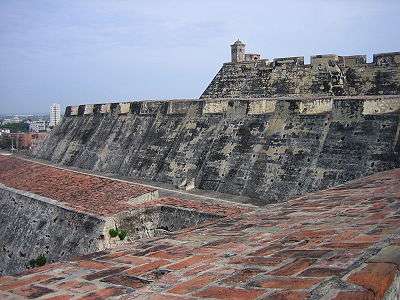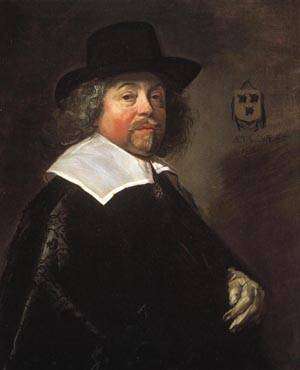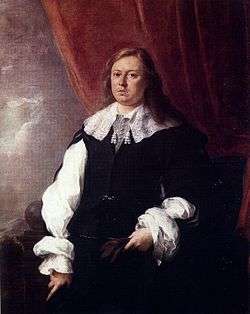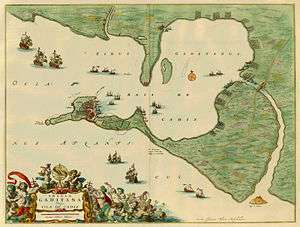Asiento
The asiento was the license issued by the Spanish crown, by which a set of merchants received the monopoly on a trade route or product.[1] They were included in some peace treaties. An example of it was the payment of a fee, granting legal permission to sell a fixed number of African slaves in the Spanish colonies. It was usually sold to foreigners, mainly Portuguese. It was considered a tangible asset, comparable to tax farming, and a source of profit for the Spanish crown.[2] The original impetus to import African slaves was to relieve the indigenous inhabitants of the colonies from the labor demands of the Spanish colonists.[3] Dutch merchants became involved in the slave trade. In 1713, the British were awarded the right to the asiento in the Treaty of Utrecht, which ended the War of the Spanish Succession. The British government passed its rights to the South Sea Company.[4] The British asiento ended with the 1750 Treaty of Madrid between Great Britain and Spain.
In Spain the asientos of the Genoveses (enemies of the Crown of Aragon) and later of the so-called Marranos or Portuguese Jews stand out.
In many cases, intra-nationally, a seat in the form of financing in the case of economies of scale resulted in a chartered company, which was a commercial company whose activities enjoyed the protection of the State by means of a special privilege, which, although it did not always constitute a total monopoly. Its existence dates back to 14th century in Italy, highlighting the British East India Company, the Dutch West India Company or the Casa de la Contratación de Indias in Seville.
Spanish Asiento
The general meaning of asiento (from the Spanish verb sentar, to sit, and this from Latin sedere) in Spanish is "consent" or "settlement, establishment". In a commercial context it means "contract, trading agreement." In the words of Georges Scelle, it was "a term in Spanish public law which designates every contract made for the purpose of public utility…between the Spanish government and private individuals."[5]
The asiento system was established following Spanish settlement in the Caribbean, when the indigenous population was undergoing demographic collapse and the Spanish needed another source of labor. Initially a few Christian African slaves born in Iberia were transported to the Caribbean. But as the indigenous demographic collapse was ongoing and opponents of Spanish exploitation of indigenous labor grew, including that of Bartolomé de Las Casas, the young Hapsburg king Charles I of Spain allowed for the direct importation of slaves from Africa (bozales) to the Caribbean. The first asiento for selling slaves was drawn up in 1518, granting a Flemish favorite of Charles, Laurent de Gouvenot, a monopoly on importing African slaves for eight years with a maximum of 4,000. Gouvenot promptly sold his license to Genoese merchants in Andalusia for 25,000 ducats.[6] The crown controlled both trade and immigration to the New World, excluding Jews, conversos, Muslims, and foreigners. African slaves were considered merchandise, and their import regulated by the crown.[7] Spain had neither direct access to the African sources of slaves nor the ability to transport them, so the asiento system was a way to ensure a legal supply of Africans to the New World, which brought revenue to the Spanish crown.[8]
For the Spanish crown, the asiento was a source of profit. "The asiento remained the settled policy of the Spanish government for controlling and profiting from the slave trade."[4] In Hapsburg Spain, asientos were a basic method of financing state expenditures: "Borrowing took two forms – long-term debt in the form of perpetual bonds (juros), and short-term loan contracts provided by bankers (asientos). Many asientos were eventually converted or refinanced through juros."[9]
Initially, since Portugal had unimpeded rights in West Africa via its 1494 treaty it dominated the European slave trade of Africans. Before the onset of the official asiento in 1595, when the Spanish monarch also ruled Portugal in the Iberian Union (1580-1640), the Spanish fiscal authorities gave individual asientos to merchants, primarily from Portugal, to bring slaves to the Americas. For the 1560s most of these slaves were obtained in the Upper Guinea regions, especially in the Sierra Leone region where there were many wars associated with the Mande invasions.

Following the establishment of the Portuguese colony of Angola in 1575, and the gradual replacement of São Tomé by Brazil as the primary producers of sugar, Angolan interests came to dominate the trade, and it was Portuguese financiers and merchants who obtained the larger scale, comprehensive asiento that was established in 1595 during the period of the Iberian Union. The asiento was extended to importation of African slaves to Brazil, with those holding asientos for the Brazilian slave trade often also trading slaves in Spanish America. Spanish America was a major market for African slaves, including many of whom exceeded the quota of the asiento license and illegally sold. Most smuggled slaves were not brought by freelance traders.[10]
Angolan dominance of the trade was pronounced after 1615 when the governors of Angola, starting with Bento Banha Cardoso, made alliance with Imbangala mercenaries to wreak havoc on the local African powers. Many of these governors also held the contract of Angola as well as the asiento, thus insuring their interests. Shipping registers from Vera Cruz and Cartagena show that as many as 85% of the slaves arriving in Spanish ports were from Angola, brought by Portuguese ships. The earlier asiento period came to an end in 1640 when Portugal revolted against Spain, though even then the Portuguese continued to supply Spanish colonies.

In the 1650s after Portugal achieved its independence from Spain, Spain denied the asiento to the Portuguese, whom they considered rebels.[11] Spain sought to enter the slave trade directly, sending ships to Angola to purchase slaves. It also toyed with the idea of a military alliance with Kongo, the powerful African kingdom north of Angola. But these ideas were abandoned and the Spanish returned to Portuguese and then Dutch interests to supply slaves. The Spanish awarded large contracts for the asiento to the Dutch West India Company in 1675 rather than Portuguese merchants in the 1670s and 1680s.[12] In 1700, with the death of the last Hapsburg monarch, Charles II of Spain, his will named the French House of Bourbon as the successor to the Spanish throne. The asiento was granted in 1702 to the French Guinea Company, for the importation of 48,000 African slaves over a decade. The Africans were transported to French Caribbean colonies of Martinique and Saint Domingue.
Britain disputed the Bourbon inheritance of the Spanish throne and fought in the War of the Spanish Succession. Although Britain did not prevail, it did receive the asiento as part of the Treaty of Utrecht. The asiento became a conduit for British contraband trade all kinds, which undermined Spain's attempts to keep a closed trading system with its colonies.[13] The asiento agreement with the British survived until 1750, when Spain was implementing a number of administrative and economic reforms. The crown bought out the South Sea Company's right to the asiento in 1750. The crown sought another way to supply African slaves, attempting to liberalize its traffic, trying to shift to a system of the free trade in slaves by Spaniards and foreigners in particular colonial locations. These were Cuba, Santo Domingo, Puerto Rico, and Caracas, all of which used African slaves in large numbers.[14]
Europeans' enslavement of Africans was not not challenged, but in 1688 Aphra Behn published Oroonoko, one of the first pieces of antislavery literature.[15]
British South Sea Company
At the conclusion of the War of the Spanish Succession, the Treaty of Utrecht gave to Great Britain a thirty-year asiento or contract, to send one merchant ship to the Spanish port of Portobelo, furnishing 4800 slaves to the Spanish colonies. This provided British traders and smugglers with inroads into the supposedly closed Spanish markets in America. Disputes connected with it led to the War of Jenkins' Ear (1739).[16] Britain gave up its rights to the asiento after the war, in the 1750 Treaty of Madrid.
Similar patents in the English system were the Virginia Company, the Levant Company and the Merchant Adventurers' patent of trade with the United Provinces (essentially concurrent with the modern day Netherlands). A detailed and well written overview of the English system is given by Robert Brenner in "Merchants and Revolution".
Holders of the Asiento

- 1518-1527 - Laurent de Gouvenot (aka Lorenzo de Gorrevod or Garrebod), Governor of Bresse and majordomo of Charles I of Spain.[17][18]
- Outsourced to Domingo de Forne, Agustín de Ribaldo and Fernando Vázquez, all Genoese established in Seville.[18]
- 1528-1536 - The Welser family.[19]
- 1536-1595 - Liberalization.[19]
- 1595-1615 - Pedro Gomes Reinel (or Reynel).[20]
- 1602-1610 - João Rodrigues Coutinho, succeeded by Gonçalo Vaz Coutinho.
- November 5, 1611 - Juan Alfonso de Molina Cano for António Fernandes de Elvas.
- January 24, 1615 - Melchor Maldonado.
- 1615-1621 - António Fernandes de Elvas.
- February 2, 1622 - Gaspar de Monteser for António Fernandes de Elvas.
- 1623-1625 - Miguel Rodrigues Lamego.
- 1631-1640? - Melchor Gómez Angel and Cristóvão Mendes de Sousa.
- July 5, 1662 – 1669 Domingo Grillo and Ambrosio Lomelín will ship 24,000 slaves in seven years, assisted by the Dutch West India Company from Curaçao and the British Royal African Company from Jamaica.[21]
- The asiento is ended because of mistrust.[22][23]
- King Charles II of England tries to acquire the asiento.
- 1670-1675 António Garcia, a Portuguese (and Sebastian de Síliceo his guarantee).[24][25]

- 1676-1679 Manuel Hierro de Castro, and Manuel José Cortizos, members of the Consulado de Sevilla. Spanish are no longer allowed to buy slaves on Curaçao.
- [Señor. El Maestro Fray Juan de Castro, Religioso de la Orden de Santo Domingo, dize : Que por el año de 1678 hollandose en la Ciudad de Cádiz, le solicitaron D. Baltasar Coymans, y Pedro Bambelle de Nacion Olandeses, para la disposicion de un Asiento, que se auia de hazer para comerciar à Indias, haziendole grandes ofertas…y auian de ser Españoles los que le auian de hazer ; y reconociendo…que se trataua de adulterar el comercio…]
- 1680 Juan Barroso del Pozo, a former assistant Coymans (?) [26] and Nicolas Porcio, his Venetian son-in-law, became asentistas.
- 1682-1688 Juan Barroso del Pozo (-1683) and Nicolás Porcio succeeded in getting the asiento for 6.5 years. It was probably Porcio who encountered many financial difficulties in 1684 and was unable to make his payments to the crown, alleging that the local authorities in Cartagena were working against his interests.[27]
- February 1685 – 1688 Balthasar Coymans (1652-1686).[24][28] Coymans made an immediate payment towards some frigates for the Spanish navy being built in Amsterdam and an advance on the dues he would be liable for on goods imported to Spanish America.[27]
- Royal Order, signed 'El Rey', commanding Don Balthasar Coymans, Don Juan Barrosa & Don Nicolas Porzio to assemble ten Capuchin monks (Franciscan friars) from either Cadiz or Amsterdam for the purpose of sailing to the coast of Africa to buy slaves, to convert them to Christianity and sell them in the West Indies, 25 March 1685 Balthasar & Johan Coymans.[29]
- Carta de Rodrigo Gómez a [Manuel Diego López de Zúñiga Mendoza Sotomayor, X] Duque de Béjar informando de la concesión de un asiento de negros en el Río de la Plata a favor de Baltasar Coymans y pide recomendaciones personales para que su hijo Pedro sea empleado en ese negocio. Menciona también a Gaspar de Rebolledo, Juan Pimentel como Gobernador de Buenos Aires y a [Carlos José Gutiérrez de los Ríos Roha, VI] Conde de Fernán-Núñez. Antwerp, 1685-04-17.[30]
- July 1686. King Charles II of Spain starts an investigation into the legitimacy of the Asiento.[31] The asiento with B. Coymans is annulled.
- October 1686 The Dutch refuse to accept the "Junta de Asiento de Negros", a commission of dubious authority.
- There is a risk of war between France and Spain; Jamaica is becoming more important than Curaçao.[32]
- 1687-1688 Jan Carçau, or Juan Carcán a former assistant of B. Coymans, takes over the asiento.
- March 1688 Jan Carçao is put in prison in Cádiz, accused of fraud. In June 1688 the commission delivered an opinion the Dutch must recognize its authority before discussions could proceed.[33]
- 1688-October 1691 Nicolás Porcio.
- 1692-1695 Bernardo Francisco Marín de Guzmán
- 1695-1701 Manuel Ferreira de Carvalho representing the Real Companhia de Cacheu or Real Companhia da Guiné do Reino de Portugal.
- 1701-1713 Jean du Casse in name of the Compagnie de Guinée et de l'Assiente des Royaume de la France.[35]
- 1713-1750 South Sea Company.[36]
- 1750 Asiento ended with Britain in the Treaty of Madrid (5 October 1750)
- 1765-1772 Miguel de Uriarte in name of Aguirre, Aristegui, J.M. Enrile y Compañía, or Compañía Gaditana.
- 1773-1779 Aguirre, Aristegui y Compañía, or Compañía Gaditana.
See also
Sources
- Blackburn, Robin, The Making of New World Slavery, London: Verso 1997,
- Goslinga, C. Ch. (1985). The Dutch in the Caribbean and in the Guianas 1680–1791. Assen: Van Gorcum. ISBN 90-232-2060-9.
- David Marley (ed.), Reales asientos y licencias para la introduccion de esclavos negros a la America Espagnola (1676–1789), ISBN 0-88653-009-1 (Windsor, Canada. 1985).
- Postma, J. M. (2008). The Dutch in the Atlantic Slave Trade, 1600–1815. Cambridge University Press. ISBN 978-0-521-36585-7.
References
- ↑ David Marley (ed. ), Reales asientos y licencias para la introducción de esclavos negros a la América Española (1676-1789), (Windsor 1985).
- ↑ Blackburn, Robin, The Making of New World Slavery, London: Verso 1997, pp. 135, 141-2.
- ↑ Haring, Clarence. The Spanish Empire in America, New York: Oxford University Press 1947, p. 219.
- 1 2 Haring, The Spanish Empire in America, p. 220.
- ↑ Postma, Johannes, The Dutch in the Atlantic Slave Trade, 1600-1815 (Cambridge University Press, 1990), p. 29.
- ↑ Haring, The Spanish Empire in America, p. 219.
- ↑ Blackburn, The Making of New World Slavery, p. 135.
- ↑ Shelly, Cara. "Asiento" in Encyclopedia of Latin American History and Culture, vol. 1, p. 218. New York: Charles Scribner's and Sons 1996, p. 218.
- ↑ Mauricio Drelichman and Hans-Joachim Voth, "Lending to the Borrower from Hell: Debt and Default in the Age of Phillip II, 1566-1598", p. 6.
- ↑ Blackburn, The Making of New World Slavery, p. 181.
- ↑ Shelly, "Asiento", p. 218.
- ↑ Blackburn, The Making of New World Slavery, p. 203.
- ↑ Shelly, "Asiento", p. 218
- ↑ Haring, The Spanish Empire in America, p. 220-21
- ↑ Wills, J.E. (2001) 1688. A global history, p. 52.
- ↑ Haring, The Spanish Empire in America, p. 333.
- ↑ Thomas, Hugh (1997) The Slave Trade. Simon and Schuster, 908 pages
- 1 2 Dalla Corte, Gabriela (2006) Homogeneidad, Diferencia y Exclusión en América. Edicions Universitat Barcelona, 447 pages
- 1 2 Cortés López, José Luis (2004) Esclavo y Colono. Universidad de Salamanca, 339 pages
- ↑ "Portada del Archivo Histórico Nacional". censoarchivos.mcu.es (in Spanish). Retrieved 2017-07-13.
- ↑ "2006.003.0002 a Documents". www.melfisher.org. Retrieved 2017-07-13.
- ↑ The slave trade: the story of the Atlantic slave trade, 1440-1870 Door Hugh Thomas, p. 213.
- ↑ The Genoese in Spain: Gabriel Bocángel y Unzueta (1603-1658): a biography by Trevor J. Dadson
- 1 2 http://www.danbyrnes.com.au/merchants/merchants7.htm
- ↑ Klooster, W. (1997): Slavenvaart op Spaanse kusten. De Nederlandse slavenhandel met Spaans Amerika, 1648-1701 in Tijdschrift voor de Zeegeschiedenis p. 127.
- ↑ Shaw, C.M. (199) The overseas Spanish Empire and the Dutch Republic before and after the Peace of Munster", In: De zeventiende Eeuw, 13 (1997), pp. 131-139.
- 1 2 Wills, J.E. (2001) 1688. A global history, p. 50.
- ↑ Davies, Kenneth Gordon (1957). The Royal African Company. Taylor & Francis. ISBN 9780415190770.
- ↑ "Spanish Slavery.- [Charle S II, King of Spain, 1665-1700 Royal Order, signed 'El Rey', commanding Don Balthasar Coymans, Don Juan Barrosa & Don Nicolas Porzio to assemble 10 Capuchin monks (Franciscan friars) from either Cadiz or Amsterdam for the". invaluable.com. Retrieved 2017-07-13.
- ↑ "MINISTERIO DE EDUCACIÓN, CULTURA Y DEPORTE - Portal de Archivos Españoles". pares.mcu.es (in Spanish). Retrieved 2017-07-13.
- ↑ The transatlantic slave trade: a history door James A. Rawley, Stephen D. Behrendt
- ↑ Négoce, ports et océans, XVIe-XXe siècles: mélanges offerts à Paul Butel Door Silvia Marzagalli, Paul Butel, Hubert Bonin
- ↑ Wills, J.E. (2001) 1688. A global history, p. 51.
- ↑ The African slave trade and its suppression: a classified and annotated… By Peter C. Hogg
- ↑ "Africa Focus: Africans in bondage : studies in slavery and the slave trade : essays in honor of Philip D. Curtin on the occasion of the twenty-fifth anniversary of African Studies at the University of Wisconsin: Chapter 2: The company trade and the numerical distribution of slaves to Spanish America, 1703-1739". digicoll.library.wisc.edu. Retrieved 2017-07-13.
- ↑


